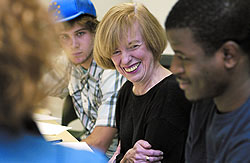

 |
||||
|
The demand for writing courses at Oberlin has surged so much that students must submit applications and writing samples to assess their "serious commitment to the nature and structure of the classes," as cautioned by the course catalog. Although burgeoning interest in the subject isn't unique to Oberlin (300 colleges offer some kind of creative writing curriculum to their students, with more than 50 adding it in the past six years), Oberlin's is one of the few stand-alone programs, having evolved from informal workshops in the 1960s to a fully implemented major in 1975. "It's rare for creative writing to be a separate entity and not a sidecar to an English department," says Professor of English David Young, who, with former program director Stuart Friebert, helped build the foundation for the program some 30 years ago. "Many writers attached to English departments are treated like embarrassing shabby cousins; they get the worst offices and the lowest raises, and they create jealousy because they often get the most and best students." The independence of Oberlin's program gives it a definite edge, faculty members say, allowing them to offer coursework that's more akin to a graduate-level MFA program but without the professional anxiety that can plague grad students. Here, creative writing majors take 25 hours of writing classes, including advanced workshops in three of the five genres. "The breadth of preparation this requires, and the discoveries it allows, produce more interesting and better-grounded writers than if we allowed students to study only the kind of writing with which they feel most comfortable," says Professor of English David Walker '72. Majors must also take 12 hours of literature classes and attend and report on readings by visiting authors. Professors teach persistence--an important attribute given the many obstacles that writers face in gaining exposure for their work. The program also hosts activities that bring quality writing to the campus as a whole, such as public readings by established writers, and funding and guidance for student publications. Finally, students have the advantage of proximity
to the Oberlin College Press, a literary press that publishes FIELD,
a respected, twice-yearly journal of contemporary poetry and poetics.
"The presence of the press creates fortunate and lively interactions
between beginning writers and the larger world of professional publishing,"
Young says. Professor and program co-director Martha Collins, author of the poetry collection Some Things Words Can Do, says the swelling number of students has led to an expansion of offerings, including workshops for non-majors and classes that connect with other fields. New this year is a playwriting concentration, in which students supplement Walker's playwriting classes with other courses in the theater department. Other writing faculty members include Chaon, a National Book Award finalist for his collection of short stories Among the Missing; poet Pamela Alexander, author of Inland and other books of poems; and Sylvia Watanabe, a fiction writer and essayist whose work includes the collection of stories Talking to the Dead. Despite its high-caliber professors and jam-packed classes, the program still faces a hurdle: the belief by some people--particularly parents--that creative writing isn't a surefire path to employment. In truth, says Young, the program's graduates "spread out in many directions and take up many occupations," including medicine, law, government, the ministry, academia, and of course all the other arts. "We're now drawing students to Oberlin who come specifically to study writing," adds Walker. "Many of our most promising students are attracted by our tradition of educating some of the best writers out there." But perhaps more important, the creative writing program continues to offer students valuable lessons and a mandate. "What comes up, again and again, is a teaching style that I first encountered at Oberlin," says poet and teacher Bruce Weigl '73. "It says that what you have to say as a writer matters, and that you have a responsibility to get the words right." |
|
|
